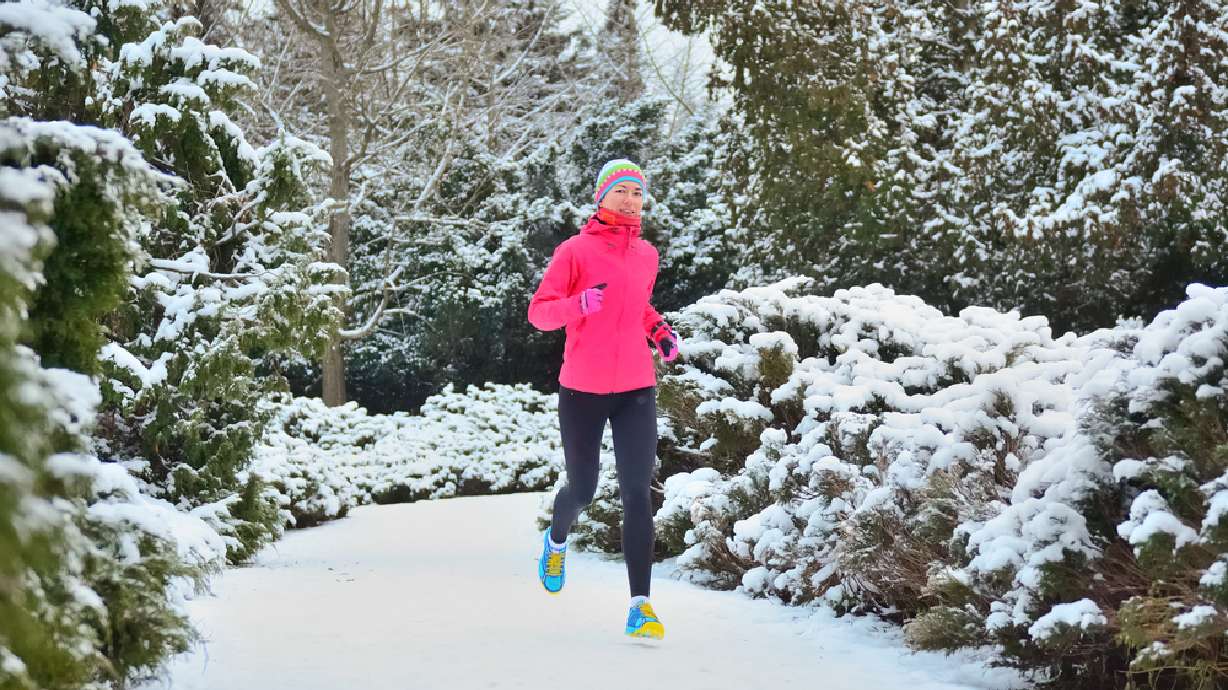Estimated read time: 4-5 minutes
This archived news story is available only for your personal, non-commercial use. Information in the story may be outdated or superseded by additional information. Reading or replaying the story in its archived form does not constitute a republication of the story.
THE GREAT OUTDOORS — Cold temperatures and snow-covered trails mean most runners hang up their shoes for the season or jump onto treadmills. Yet, empty trails and frosted scenery lure adventurous runners to jog through the winter months.
Local trail runners Liz Allen and Nate Blouin shared their tips on how to run in the mountains year-round.
How to dress
The No. 1 rule to running during the wet, winter months is to not wear cotton. Since it absorbs moisture, cotton remains damp once wet. Allen suggests a mid-weight base layer, like Patagonia’s Capilene long-sleeve shirt. One layer is sufficient if running in temperatures between 25 and 40 degrees Fahrenheit.
Running to a peak or while it is snowing requires a light, windproof outer layer. You can put it on at the peak to trap in heat for the run down. Both Allen and Blouin recommend bringing gloves, and a change of gloves if running for more than two hours. Also, a change of socks can be a lifesaver after getting snow-filled shoes.
Beanies and neck buffs also help trap warmth inside, and are easier to remove if you overheat. You can store extra layers in a small pack or vest— Salomon and Ultimate Direction make great ones.
Extra equipment
Trekking poles mean your pole punches through the snow if you stumble, not your hand. Also, they can be used to check snow depth before you step. Gaiters are great if you are running the first tracks up a snowy mountain. As for footwear, look for shoes with big rubber lugs; they have more traction and better grip in icy conditions. You can also add spikes to your shoes, too; micro-spikes are better for snow while nano-spikes are made for ice.
If on a longer run, bring soft granola bars (Allen likes fig bars and Honey Stinger’s Waffles) or snacks that are bite size (think GORP and fruit snacks). Keep them close to your body so they don’t freeze.
To keep water in hydration packs from freezing, blow water back through the hose and insulate the water bag.
Tips and tricks
Before your run, warm up your body.
“It’s nice to have a little heat generated before you get out the door,” Blouin said.
Dynamic stretches help prep your muscles to run in the cold. Snow on the trails can be tricky to read, so take it easy for the first couple of miles until you know the terrain. Be conscious of where you are putting your feet, and take slower, smaller steps.
As for downhills, Allen said it is best to just let it go. Lift your knees and your feet, and you will keep going down. You may fall, but one of the benefits of winter trail running is you don’t get bloody elbows or knees since you fall on powder, not rocks.
“Have a mindset of being able to laugh at yourself. You’re out there to go out and play in nature anyway,” Allen said. “You chose to be out there, so have fun with it.”
Where to run
Most winter trail runners stick to paths with high foot traffic (so it's more packed down) and low elevations, such as the Bonneville Shoreline Trail and Millcreek’s Pipeline Trail. Branching off of the Bonneville Shoreline Trail, runners can reach Mount Van Cott, Little Black Mountain or even Ensign Peak and Rudy’s Flat in the winter.
Runners can also summit Gobbler’s Knob, Mount Raymond’s, and Grandeur Peak (both east and west trails) in the Cottonwoods. Round Valley near Park City has excellent groomed trails, and you can check conditions at Mountain Trails Association.
Stay safe
Stick to trails you know and don't wander off of them, since avalanche danger is a threat even amongst runners. Be courteous, Blouin said, and keep off the skin tracks of skiers and split-boarders. Check avalanche conditions at Utah Avalanche Center and don’t run alone where avalanches are a possibility. Wasatch Mountain Wranglers is another great resource to find both running partners and learn about trail conditions.
What other good advice do you have for trail runners who venture out in the winter? Let us know in the comments.








